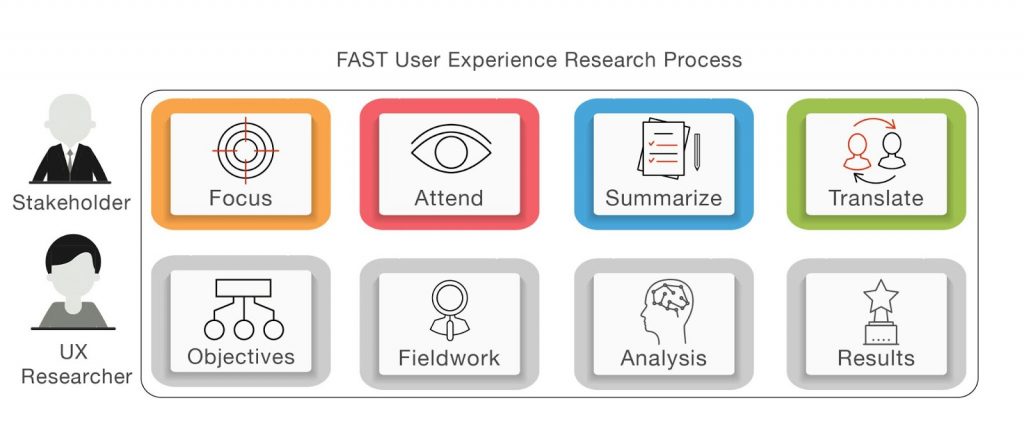User experience plays a vital role in the success of SaaS solutions. Businesses are investing millions of dollars in hiring UX developers and building design centers. According to research by Forrester, one dollar spent on user experience yields a 100 percent return, which equals a return on investment of 9,900%.
Design errors are costly to the SaaS businesses that allow them. This poses serious implications for the company involving both the loss of money and the loss of customers. 90% of users quit using applications due to poor performance. According to PWC, 32% of clients would refuse the company’s services after just one negative experience. Thus, the UX research for SaaS companies that helps to prevent the above-mentioned problems is a necessary and useful procedure.

Why SaaS UX Research Is Important
User experience research is one of the most important activities in the SaaS product development process. It helps to clarify the objectives for your team, make the necessary adjustments and understand the problems the product would solve for its users.
UX research for SaaS startups allows reducing software updates after release and ensures user-friendliness. It also helps to save a ton of time and effort and avoid expensive mistakes. UX research is a way to satisfy the users’ requirements and deal with the significant issues before the launch of the system. With the help of this method, you can identify the early adopters who are ready to purchase and use your product. These people can also provide valuable feedback concerning the application’s features and functionality.
The companies that skip the SaaS UX research phase because of lack of time or doubts on its necessity often face a product failure. Even if the idea of the future product looks good on paper, it requires testing. In another common case, businesses try to solve the UX issues by adding functionality to the existing system, which often leads to new problems. Most often, at this stage, the companies would have to create the product from scratch, which is risky as it requires a lot of time and resources.
If there are some errors in the finished application, user research would help to determine how to redesign the product, where to start, what is the greatest priority, and what aspects need to be changed for users’ benefit.
UX Research Benefits
There are many benefits of UX research for SaaS companies, especially in the early stages of the application lifecycle. The major advantages of the SaaS UX research include:
- early design errors prevention;
- user satisfaction;
- less time for task completion;
- less spendings on user support.
When to Conduct User Experience Research
SaaS UX research can be carried out at any stage of the design process. You can learn something useful at every phase of the project, and each step of the research would add some valuable points to your product at more than the expense of the study. There are several types of user experience research intended for different phases of the project.
Early stage
At the early stage of the project, UX research can help gain insights into the users’ behavior, needs and wants, competitors, assessment of the needed functionality and preliminary plan development. During the early stage, user research will provide you with an understanding of the features that allow you to be successful in the market and have a competitive advantage.
It is important to start the research in the early stage as the results at this point would have a greater impact on your product and you would be able to make the necessary changes. You can conduct the UX research at the early stage but set aside some costs for the supplementary research at the subsequent stages.
The methods applied at this research phase include user and stakeholder interviews, competitive testing, diary studies, sales and support interviews.
Prototype Stage
At the design stage, SaaS startup UX research enables you to confirm hypotheses and allows you to estimate if the chosen plan is right before investing in development. In addition, user experience research at the prototype phase is effective if you are going to analyze how the project is moving forward and test the controversial decisions.
The common methods used at the prototype stage include design review, persona building, prototype feedback and testing, task analysis.
Post Launch Stage
When the project is already launched, you can conduct surveys and other research to further improve the website usability. After the launch, you need to establish the market position and optimize the product experience. If you carry out the research during the post launch stage, you can address any issues that arise as the project progresses.
Once your product has established its position in the market, you will need to add new or advanced features to fulfill the requirements of the specific customer segments. As you introduce these enhancements, you can apply the same steps of the research and testing process you used before the initial launch. User research helps to ensure that you are developing the appropriate product for the customers in the most efficient way possible.
The commonly applied methods include qualitative usability testing, accessibility evaluation, usability bug review, feedback review, surveys and FAQ review.
Best UX Research Practices
Small Research Is Better than Nothing
There is a common misperception that user experience testing requires huge investments and a great amount of time. However, the reality is that small tests involving about five users bring the best results. For greater efficiency, you can run a series of small tests with several participants. When you perform testing with more than five users, you receive the same results as during the previous observations, so it is often a waste of time.

Involve a Specialist
We use an individual approach to every project depending on your needs. Due to our extensive knowledge in design, we can conduct high-level SaaS UX research. During the user experience research stage, we most frequently conduct user interviews, stakeholder interviews and competitive analysis. We will find the most appropriate user experience research methods for your project to make the most of the testing.






